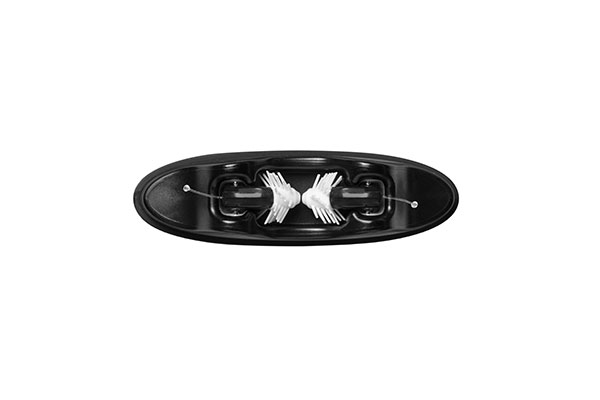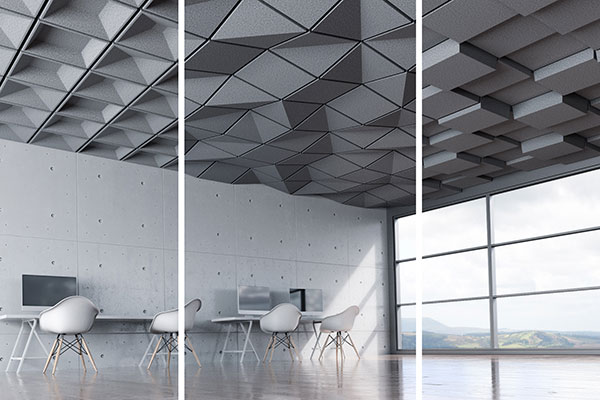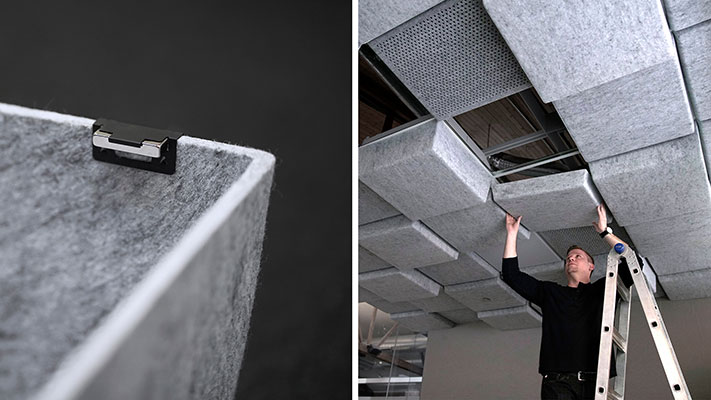Novel hearing aid and ceiling tiles among 145 honorees in 2018 competition
Hear, hear! A new type of hearing aid, and some novel acoustic ceiling tiles. Two Gold-winning entries in the Industrial Designers Society of America’s recent 38th annual design competition had to do with two very different aspects of hearing –– and helped to underscore the variety of entries in this rigorous contest. And, as usual, plastics played a key role in these and many of the other impressive products recognized by IDSA this year.
Find solutions, not just materials
Prospector® lets you compare materials side-by-side, and quickly find alternatives. Learn how premium search can help you bolster your product design, processing and production.
View search options now
The 2018 International Design Excellence Awards, or IDEAs, attracted a record number of 1,872 entries from around the world, and an international, 32-person jury selected 145 winners –– 32 gold, 52 silver and 61 bronze. All were honored at an awards ceremony held Sept. 19 at the World War II Museum in New Orleans, during the group’s annual International Design Conference.
Michael Kahwaji, senior design manager at Whirlpool Corp., served as jury chair, and offered his take on a couple of the entries that interested him most. As it happens, he awarded his special Jury Chair Award to the same product –– the Eargo hearing aid –– that earned the Plastics Innovation Award. That latter award was first presented last year and is chosen by the Washington, D.C.-based Plastics Industry Association (aka PLASTICS) from among the IDEA Gold winners to recognize “the most creative, innovative and best plastic application design.”
A new type of hearing aid

Mountain View, Calif.-based Eargo Inc. worked with San Francisco design firm Ammunition to complete its latest device, which offers a fresh take on the traditional hearing aid. The tiny, rigid plastic body — made of a PBT/polycarbonate blend — slides into the ear canal and is comfortably suspended by Eargo’s patented Flexi Fibers, which are white “fingers” made of soft, medical-grade silicone rubber.
“More than 48 million Americans currently experience hearing loss,” Eargo notes, “and 80 percent of them do nothing about it. Their denial has many different shades, but more often than not it’s related to social stigma and cost.”
A Class I, FDA-regulated hearing device designed for adults experiencing mild to moderate hearing loss, Eargo features earbuds that are small and virtually undetectable to others. A tiny, clear nylon thread is all the extends out of the ear canal, and is what users grasp to extract the device from their ear.

The product’s design means the ear canal is not entirely blocked as with traditional hearing aids. Not only is this said to be healthier for the user, but it also delivers more natural sound since it allows bass sounds to travel into the ear, eliminating the need to amplify them. With Eargo, only treble sounds need to be amplified.
The rechargeable device was invented by a surgeon and initially developed by Eargo Inc., which then engaged with Ammunition to refine the product, and design both the multifunctional carrying case and the packaging, according to Steve Lee, a senior industrial designer who headed Ammunition’s Eargo design team.
In a Sept. 21 interview at the New Orleans conference, Lee explained that this project took Ammunition out of its comfort zone, since the design firm largely focuses on creating mass-market consumer-technology products. This hearing aid demanded careful attention to user experience factors, since users of the device might have low dexterity, or be trying to insert them in low light conditions.
The small, pebble-shaped charger case that Ammunition designed fits in your pocket and boasts a soft-touch paint applied over an ABS/polycarbonate shell. It has multiple purposes—to store, protect, dry and charge the earbuds.
The product also is more accessible to many, given that its pricing starts at $1,999 per pair, which is less than half of most traditional hearing aids. Learn more at www.eargo.com and www.ammunitiongroup.com .
Kahwaji said he chose to give Eargo his Jury Chair prize for several reasons –– beyond its simplicity, performance and design. “Mainly, I truly appreciated the empathy the designers practiced when developing this fresh take on assistive devices. From the unboxing experience, to the first-time use, as well as the maintenance, everything was considered.”
Recycled PET Turf on the ceiling
Scott Wilson, founder and CEO of design firm Minimal (MNML), found the noise levels inside his downtown Chicago office, adjacent to the elevated Loop train system, to be way too disruptive. Conventional ceiling tiles just didn’t do the trick, so he started exploring how to improve the office’s acoustics.
Wilson, former Nike global creative director and one of TIME magazine’s and Fast Company’s Most Influential Designers, was well aware that acoustic levels and noise within modern open spaces and hard-surface environments can be a constant distraction that impact productivity and focus. It made sense to team up with another Chicago company, Turf Design, which is devoted to developing a wide range of tile systems to dampen the din caused by uncontrolled, open-space acoustics.
Wilson soon realized that most solutions are limited, very expensive and frequently require specialized installation. So, he and his team –– including MNML designers Dave Seal and Arvid Roach, mechanical engineer Keith Alsberg, and Turf’s Jason Gillette –– got to work.
As a result of the exploration, MNML created a wide variety of three-dimensional acoustic tile designs, ranging from the pure and geometric to the complex and organic. “The result transcends product and becomes part of the space’s architecture,” says Wilson, while also allowing for endless customization.
Dubbed the Turf Acoustic Ceiling Tile System, the modular system earned a 2018 Gold IDEA in the Environments category and is now part of the extensive Turf product catalog.

On its website, Turf states its devotion to keeping waste to a minimum. “Our systems are made from 99 percent post-consumer PET plastic, with half of that coming from single-use water bottles. We manufacture on demand, which keeps inventory associated waste low,” the company says.
“From a materials standpoint,” noted Wilson in MNML’s award entry submission, “finding the proper Class A fire-rated material was a challenge and recycled PET is usually not a finished face material. We turned to the automotive industry and leveraged their use of PET felt for liners in trunks, car door panels, and bus interiors.”
All Turf ceiling tiles are made from 5 mm PET felt board. The 24-inch-square tiles attach easily to existing metal drop-ceiling grid frameworks, using rare-earth magnets to snap into their frames instead of relying on any kind of hardware or fasteners. As a result, virtually anyone can install the tiles –– including ceiling contractors, painters, electricians or facilities managers.

The system, MNML declares, “is an intelligent solution to environmental noise that leverages inspiring aesthetics, customer expression and customization, functional design and engineering, low-cost manufacturing, recycled materials, and magnetic plug-n-play, contractor-friendly installation onto drop-ceiling grids.”
MNML also praises Turf’s ability “to offer functional performance and transformative aesthetics without compromise while complementing existing construction workflows and budgets.” The product’s typical price is $25 per square foot, or $100 per tile.
Jury chair Kahwaji said: “I appreciated the Turf acoustic ceiling tiles for two reasons. First, it uses recycled plastics to create a new and useful product that’s not only beautiful, but also affordable for small and mid-sized business. Secondly, it’s a very simple installation process. This product fills a gap in the market and delivers a sound management solution with a low barrier for entry. ”
Learn more about the project at www.MNML.com/turf and at www.turf.design. And check out all this year’s winners on the IDSA website at http://www.idsa.org/IDEA.
All images provided by IDSA.
The views, opinions and technical analyses presented here are those of the author or advertiser, and are not necessarily those of ULProspector.com or UL Solutions. The appearance of this content in the UL Prospector Knowledge Center does not constitute an endorsement by UL Solutions or its affiliates.
All content is subject to copyright and may not be reproduced without prior authorization from UL Solutions or the content author.
The content has been made available for informational and educational purposes only. While the editors of this site may verify the accuracy of its content from time to time, we assume no responsibility for errors made by the author, editorial staff or any other contributor.
UL Solutions does not make any representations or warranties with respect to the accuracy, applicability, fitness or completeness of the content. UL Solutions does not warrant the performance, effectiveness or applicability of sites listed or linked to in any content.



According to the IDSA (Industrial Design Society of America) “Industrial Design (ID) is the professional service of creating and developing concepts and specifications that optimize the function, value and appearance of products and systems for the mutual benefit of both user and manufacturer.”